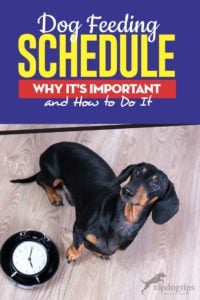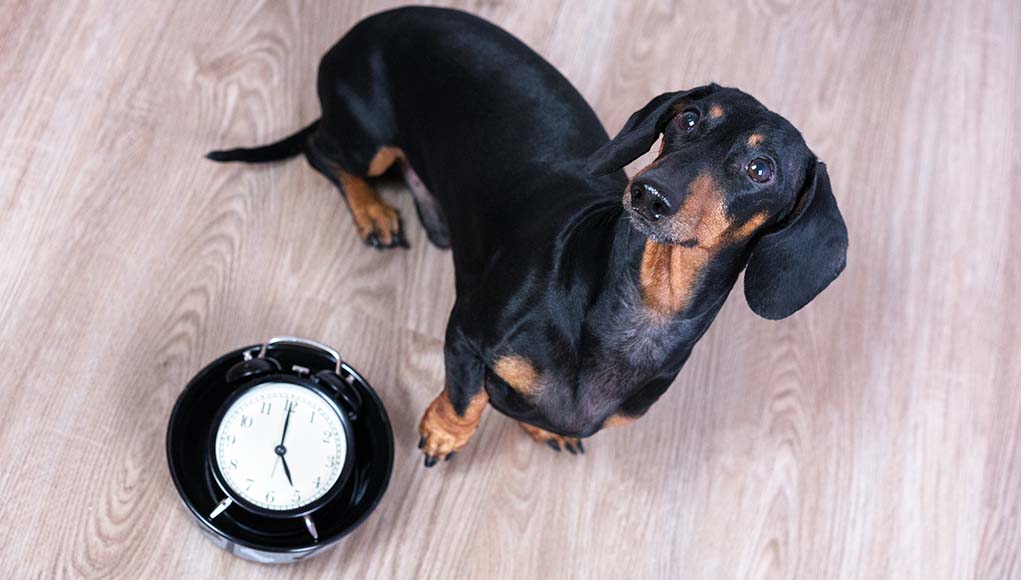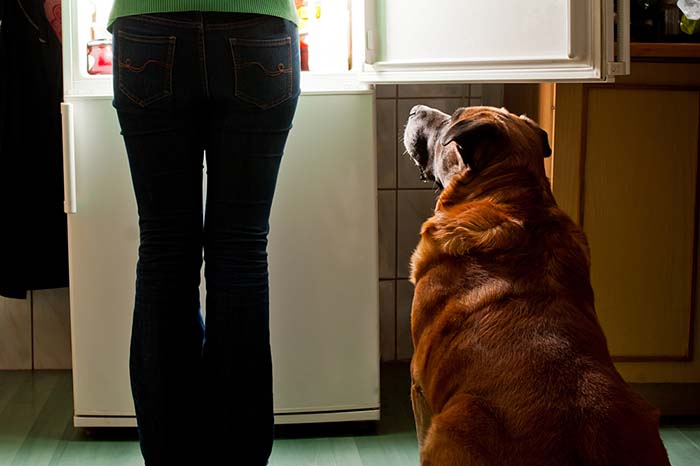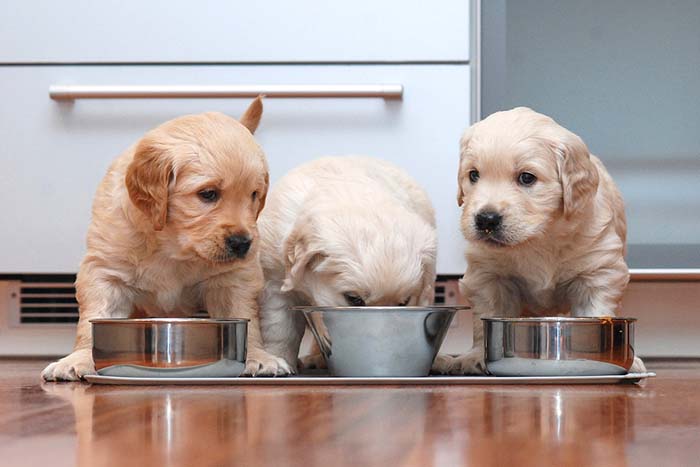Much like human children, domesticated dogs rely and depend on their human-owners that take care for them to create and maintain a feeding schedule that allows the animal to eat at the same time each day. If you the dog owner do not adopt and keep a schedule for your pooch, the pet can be negatively impacted in quite a few ways.
Below, I will list reasons why following a dog feeding schedule is important for a pet's health and overall well-being. Following the list is information about a few must-know facts related to dog feeding schedules and several resources that can be read for further information about this topic (which I highly recommend).
9 Reasons Dog Feeding Schedule is Important
1. To Prevent Obesity
Feeding a dog on a schedule allows pet owners to control the number of calories that their dog is taking in each day. If a dog is allowed to free-feed, it greatly increases the risk of he or she overeating and becoming obese, which is a very serious threat to the dog’s health.
2. To Regulate and Monitor the Dog’s Appetite
It is important to know if your dog has lost his or her appetite, as this can be an indication of a number of serious health problems. If a dog is free fed, it is much more challenging to monitor their appetite, and know if, or when it changes. Scheduled feedings allow an owner to know immediately, if their dog is skipping a meal, which could save the dog’s life because the sooner a dog is seen by a veterinarian, the better their chance of getting better will be.
3. To Regulate the Dog’s Potty Times
Feeding schedules are especially helpful when potty training a new puppy, but also for dogs that are left in their kennels for any extended period of time because owners can better regulate when the dog needs to use the bathroom, because most dogs will go potty within a certain amount of time after eating.
4. Dogs Are Creatures of Habit
Wild dogs prefer to eat at the same time every day. So, scheduled feedings more closely match the ways in which a dog would eat in the wild. However, unlike a wild dog, a domesticated pet is completely dependent on their owner for when they are fed.
If a dog is fed at the same, scheduled time each day, they will become less anxious due to not having to wonder when their next meal is coming. This will also cause a dog to trust their owner more, and form a stronger bond with them, because they know they can depend on that person to consistently take care of them.
5. For the Dog’s Emotional Well-being
Feeding a dog on a schedule will help the dog to see their owner as a fair and stable leader of the pack that can be trusted and respected. This will lessen, or completely eliminate any anxiety the dog might have, and also cause the pet to feel more secure and bonded with their owner, which promotes a better overall emotional well-being in the dog.
Additionally, if a dog suffers from separation anxiety, having the owner feed the dog before they leave the house will give the dog something to look forward to, and allows the pet to positively associate the happy feelings that come with getting food with their owner leaving, instead of being anxious and worried about it.
6. To Create Meal Manners
This is especially important in households that have multiple dogs, and for dogs that are often fed in the presence of other dogs. If meal manners are not established, a multitude of negative things can occur, such as a dog becoming possessive over meals and aggressive about food, in general.
Furthermore, if there is more than one dog in the household, the most aggressive and/or largest dog will often eat all of the food, leaving the other animals in the home hungry, and potentially making themselves sick due to overeating. Also, if you have pets on a special diet, and free-feed, there is no way to make sure that each pet eats only the food that they are supposed to eat.
7. Scheduled Meals are Valuable Training Opportunities
Meal times are a perfect opportunity to train, and teach a dog that only good behaviors are rewarded. Because the dog is hungry, and relies on their pack leader (their owner) to get fed, the dog’s owner can easily teach and reinforce positive behaviors at meal times by making their dog sit patiently and wait for their food.
Meal times also provide an opportunity for dog owners to teach their pet self-control by allowing the pet to be present as the meal is made, but making he or she sit patiently and wait to be fed.
8. Allows the Dog to Have More Variety in Their Diet
If you free-feed your dog, you can only feed them dry food because any other variety of food will become rotten and dangerous for the dog to eat if it sits out for an extended period of time, not to mention having to deal with all of the unwanted critters dog food attracts when it is left sitting out.
9. To Maintain Clean House Habits
As mentioned directly above, leaving dog food out in order to let pets free-feed will attract a multitude of unwanted and potentially dangerous critters and pests, such as ants, flies, cockroaches, mice, and many more creatures that you do not want lurking around your home, and in your dog’s food.
RELATED: 9 Tips on Feeding Dogs With Sensitive Stomachs
5 Tips About Your Dog's Feeding Schedule
1. Recommended Feeding Schedule for a Puppy
Puppies are only able to eat fairly small amounts of food at a time, therefore they become hungry more often, and should be fed accordingly. Puppies can commonly be fed up to four times a day, and feedings should be spaced evenly throughout the day. If the puppy is especially small, he or she may need fed more often.
2. Recommended Feeding Schedule for an Adult Dog
Adult dogs should be fed only twice a day. Feeding should be spread out evenly throughout the day, and be at the same time each day. Canine experts often recommend feeding an adult dog twice a day, 12 hours apart. For instance, feed the dog at 6 a.m. (before you leave for work) and at 6 p.m. (after you return home from work).
But scheduled feedings will work at any time in the day, as long as they are spread out enough to make sure that the dog has time to work up their appetite, and remain consistent.
3. How Much Should a Dog be Fed?
How much a dog should be fed each day is based on the weight of the dog. Toy breeds that weigh less than 10 pounds only need 1/4 to 3/4 of a cup of food a day, on average. If the dog is very active, he or she could require up to 1 cup of food per day.
Small breeds weighing 10 to 25 pounds need 3/4 to 1 cup of food per day. Medium breed dogs that weigh 25 to 50 pounds require 1 to 2 cups of food per day. Large breeds need up to 2 1/2 cups of food each day. And extra-large breeds require 2 to 4 cups of food per day.
For any size dog you can replace 1/2 of their required daily volume of food with the same volume of wet food, if you’d like to incorporate wet food into their diet. When feeding a dog twice a day, give half of the daily required volume of food to the dog at each scheduled meal time.
4. How Long Food Should Be Left Out for the Dog at Feeding Times
In order to teach a dog that they must eat their food at the scheduled feeding times, the food cannot be left on the ground for extended periods of time, as that is akin to free-feeding.
 It is best to leave the food down for your dog to eat for a time period between ten to twenty minutes in length, depending on how well-trained and used to eating on a schedule the dog, as well as the dog’s age and type of food they are fed, which all have an effect on how quickly he or she can eat their meals.
It is best to leave the food down for your dog to eat for a time period between ten to twenty minutes in length, depending on how well-trained and used to eating on a schedule the dog, as well as the dog’s age and type of food they are fed, which all have an effect on how quickly he or she can eat their meals.
5. What to Do If the Dog Won’t Eat During Scheduled Meal Time
If you are 100% certain that your dog is not having difficulty eating due to being ill, in any way, you can withhold treats for a few days and also skip one scheduled feeding, in order to allow the dog to become hungrier and therefore more motivated to eat their food during the next scheduled mealtime.
READ NEXT: How Much Should You Feed Your Dog















